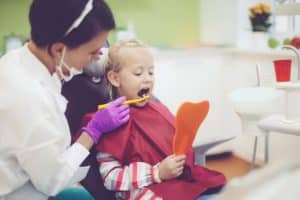Why Are Children Dying in the Dentist’s Chair?
 A story on the TV program “Sunday Night with Megyn Kelly” highlighted the recent string of deaths of children in dentist’s chairs across the United States. Many adults are afraid and anxiety about going to the dentist for a dental procedure, but we go, and we sit through it with just Novocain as a local anesthetic.
A story on the TV program “Sunday Night with Megyn Kelly” highlighted the recent string of deaths of children in dentist’s chairs across the United States. Many adults are afraid and anxiety about going to the dentist for a dental procedure, but we go, and we sit through it with just Novocain as a local anesthetic.
Children do not sit still, and they may be overwhelmed by the lights, the sharp implements and have difficulty holding their mouths open and allowing the dentist to get their work done. So, some dentists, for complicated procedures and for oral surgery, will administer anesthesia to their small patients. The challenge is, children’s lungs are much smaller than adult lungs. If something goes wrong with the anesthesia and the child stops breathing, a child’s small lungs run out of oxygen much faster thereby making injury and death more likely.
Anesthesia can be deadly for children
In the NBC story about children dying in the dental chair, adverse reactions to anesthesia was the culprit in the children’s deaths and permanent injuries:
- Novea Hall was a two-year-old whose dentist administered laughing gas, Novacain and Demerol for a dental procedure. The little girl began having seizures because her brain was being deprived of oxygen. Her dentist waited more than 4 hours to call 9-1-1, but in those intervening hours called a pharmacist for advice and called her pastor to pray with her. Novea was left unable to walk or talk and requires around-the-clock medical care. Novea’s dentist’s license was revoked and she admitted that she waited too long to call 9-1-1.
- Caleb Sears was a four-year-old boy who stopped breathing within a few minutes of being sedated by his dentist. There was an apparent delay in calling paramedics, the dentist tried to intubate him and broke his front teeth in the process. Caleb died a few days later of organ failure from the botched anesthesia in the dentist’s chair.
Kate Snow, the reporter for this story, said that her team found more than 50 cases involving children dying due to adverse effects of sedation by dentists. Dr. Karen Sibert, who is president of the California Society of Anesthesiologists, said that virtually every one of those deaths were preventable.
One of the central questions of this story was whether dentists should be permitted to administer anesthesia on young children and perform dental work at the same time. Dr. Wendy Sue Swanson from the American Academy of Pediatrics believes that dentists should stop multitasking with general anesthesia. The family of Caleb Sears was supporting a bill in the California legislature that would require dentists to have an anesthesia specialist in the room when they administer anesthesia to children younger than seven-years-old.
The American Board of Legal Medicine reports that about 13.1% of medical malpractice claims in the U.S are filed against dentists, and that plaintiffs win dental malpractice cases in court almost 40% of the time, but just as in any other medical malpractice case, the plaintiff must prove a direct line of causation between the dentist’s negligence and the injury.
If you have questions about medical malpractice for dental procedures, please contact Paulson & Nace, PLLC through this contact form or by calling 202-463-1999.

For more than 40 years, Barry J. Nace has worked to protect the rights of victims of medical malpractice and other personal injuries. Throughout his career, he has proven that multimillion-dollar awards are not a matter of luck, but the result of experience, hard work, outstanding trial skills, and an unquestioned dedication to justice. To date, Mr. Nace has produced dozens of verdicts and settlements in excess of $1 million with three in excess of $30 million. Read more about Barry J. Nace.
